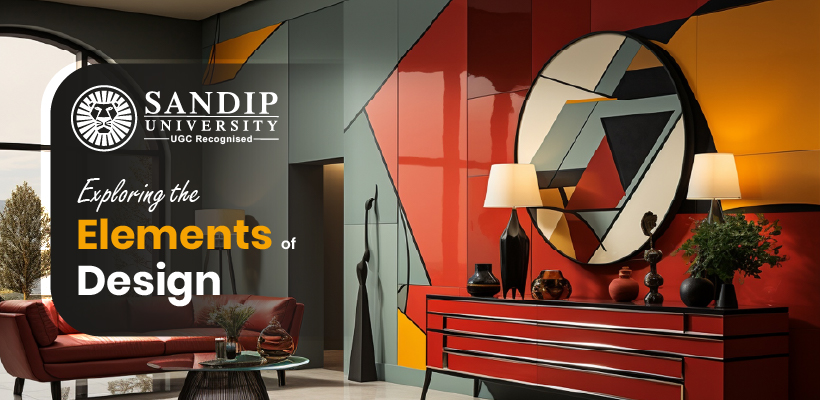The elements of design refer to the concepts and fundamentals that make up any Interior, Architecture, painting, drawing, graphic design, etc. An understanding of these design concepts and elements are necessary so that as a designer, conscious and purposeful choices are taken as design choices may change how a brand is perceived, how a document is read, and more. The main elements essential to any design are line, direction, colour, value, texture, shape, scale, and typography. Pursuing a B.Des. in Space and Interior Design can help you further understand the elements of design and their application when redesigning a particular space. Let us further explore the elements of design:
The Elements of Design
Line
A line can be described as any two connected points, linear marks made with a pen or brush, or the edge created when two shapes meet. There are various types of lines including vertical, horizontal, diagonal, zigzag, and curved lines. Lines are useful for the following objectives:
- Dividing space Creating visual organisation
- To lead or draw the eye to a specific location
- To suggest moods or emotion as lines can appear anxious, angry, or calm.
Direction
- Horizontal: Suggests calmness, tranquillity, and stability
- Vertical: Suggests balance
- Diagonal: Suggests movement and action.
Colour
Colour (also called hue) creates a mood, an ambiance for the piece and it’s typically the most obvious element of design. Each colour has its own culturally associated meaning (the colour red is often linked to love or anger), meaning that different cultures create their own meanings and impressions on colours as there is no universal meaning associated with each colour. However, the use of colour in design can alter one’s impression of the design or brand. Keep the colour wheel and colour theory in mind when incorporating more than one colour into a design. Use colour for the following strategies:
- Repeating colours: Suggests connection between elements and offers visual organisation.
- Colour as contrast: Use contrasting colours to draw attention to an element.
- Plan: Choose a colour scheme, a colour plan right from the beginning of your design phase so that colour is consistently present in your design.
Texture
Texture is more than what you can touch. It is the surface quality of a shape. A shape can be smooth, hard, glossy, or striated (striped, streaked). It can provide a three-dimensional look to any design and build an immersive and texturised experience. For example, the audience feels more connected to a design, finds more depth, as well as an impression in a business card with a wood-streaked print rather than a typical business card with a white background. There are two types of texture:
- Actual/Real Texture: Texture you can physically feel such as the weight of a business card, the gloss of a piece of paper.
Space
Space refers to the area within, around, above, or below the things. When creating, consider how the elements on the pages are grouped and arranged in your composition. Try to give elements room to breathe and don’t forget about the positive or negative space on the page. Negative space refers to the area of the page that is left void and assists in creating the overall image. These spaces are usually empty but can also be other colours. Space and shape tie together as you can use positive or negative space to create shapes as you would any other element.
Shape
Shape can be defined as a self-contained defined area of geometric (Triangle, square, rectangle) or organic form (undefined shapes). They are typically defined by boundaries such as line or colour. Every element on the page you’re designing has a shape and creates invisible shapes in relation to each other. Make sure to always consider the shapes you are intentionally incorporating as well as any shapes naturally formed by others on page
Scale
Scale (also known as size) refers to the relationship of area covered by one shape to that of another. Thus, an element can look uneven depending on the size, colour, and placement of the other elements surrounding it. How you utilise size will have an impact on how your audience views the composition of your design. Use of scale for these objectives:
- Creating interest: A design could lack interest if every element is the same size.
- Creating contrast: Making one element smaller or larger than another adds contrast and visual organisation to a design.
- Conveying importance: The larger an element is, the more important the reader will view the element.
Conclusion
Design elements should serve to guide the development and implementation of specific designs. This requires that researchers address the aspects of design principles presented in our model, as to why, who, what, how, when and which criteria apply to articulate, enact and evaluate the design elements. We argue that the continual articulation and adjustment of design elements should not only be seen as refinement, but also as a contingent process involving local agency, allowing unexpected challenges and valuable insights to emerge. Pursuing a degree program from one of the top interior design colleges in Nashik can help you become a skilled designer in the interior design industry. Good luck!

